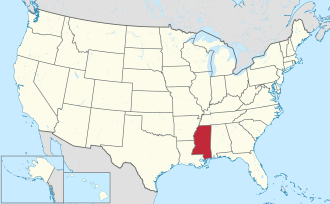Tunica County | |
|---|---|
 Tunica County Courthouse in Tunica | |
 Location within the U.S. state of Mississippi | |
 Mississippi's location within the U.S. | |
| Coordinates: 34°40′N90°23′W / 34.66°N 90.38°W | |
| Country | |
| State | |
| Founded | 1836 |
| Named after | Tunica-Biloxi tribe |
| Seat | Tunica |
| Largest town | Tunica Resorts |
| Area | |
• Total | 481 sq mi (1,250 km2) |
| • Land | 455 sq mi (1,180 km2) |
| • Water | 26 sq mi (67 km2) 5.4% |
| Population (2020) | |
• Total | 9,782 |
• Estimate (2024) | 9,157 |
| • Density | 21.5/sq mi (8.30/km2) |
| Time zone | UTC−6 (Central) |
| • Summer (DST) | UTC−5 (CDT) |
| Congressional district | 2nd |
| Website | www |
Tunica County is a county located in the U.S. state of Mississippi. As of the 2020 census, the population was 9,782. [1] Its county seat is Tunica. [2] The county is named for the Tunica Native Americans. Most migrated to central Louisiana during the colonial period.
Contents
- Geography
- Major highways
- Adjacent counties
- Demographics
- 2020 census
- 2010 census
- 2000 census
- Economy
- Education
- Notable people
- Communities
- Town
- Census-designated places
- Unincorporated communities
- Ghost towns
- Politics
- See also
- References
- External links
Tunica County is part of the Memphis, TN-MS-AR Metropolitan Statistical Area. It is located in the Mississippi Delta region.
Since the late 20th century, it is known for Tunica Resorts (formerly Robinsonville), an unincorporated community that is the site of six casino resorts. It is one of the top six destinations in the country in terms of gambling revenues. [3]








